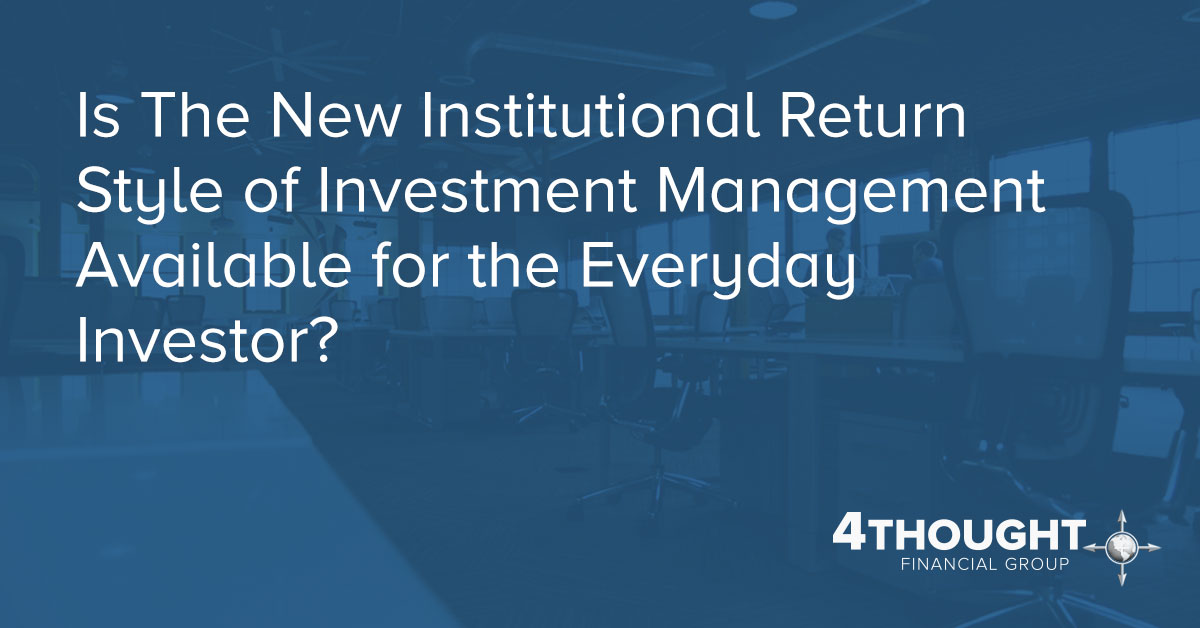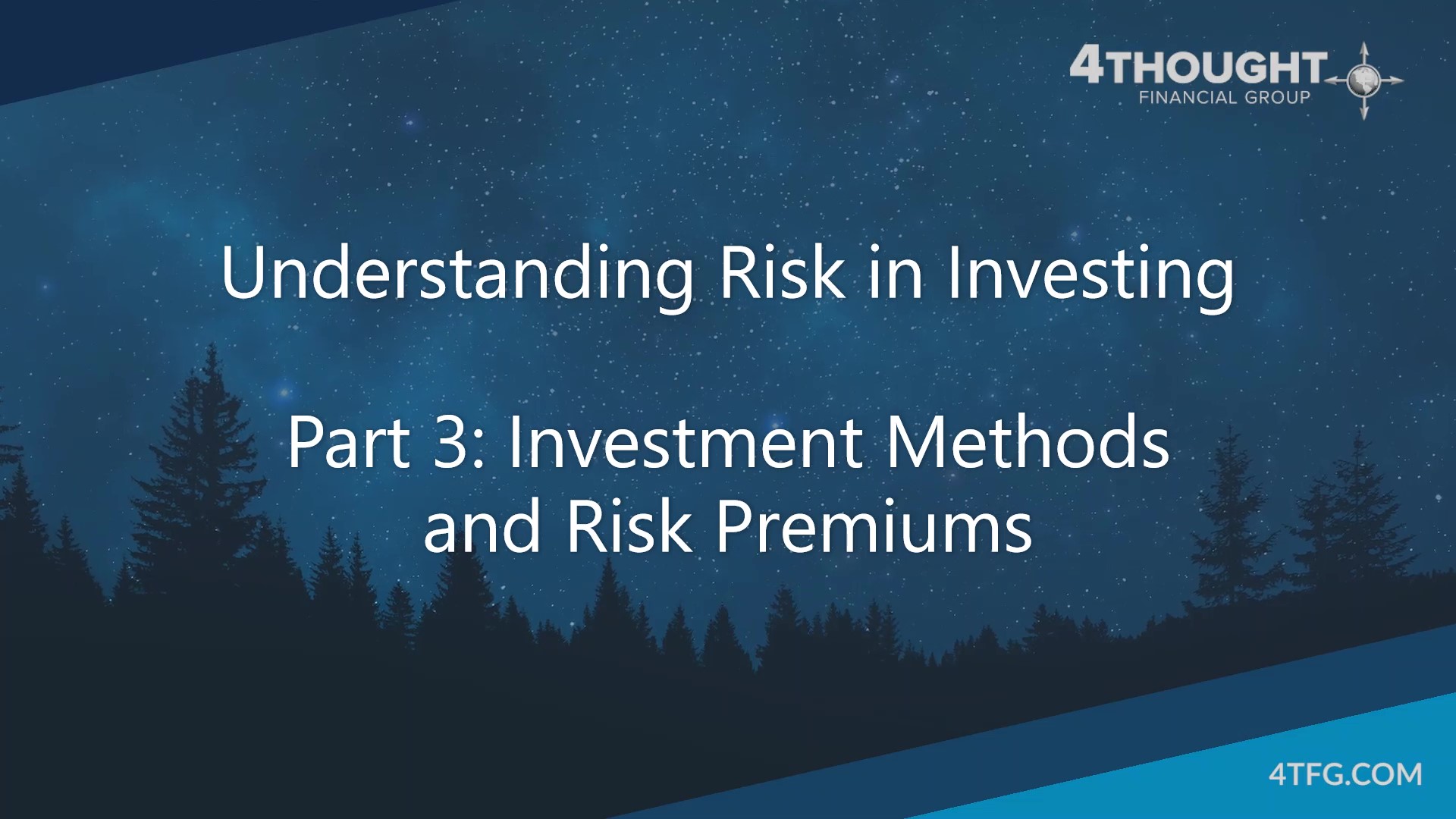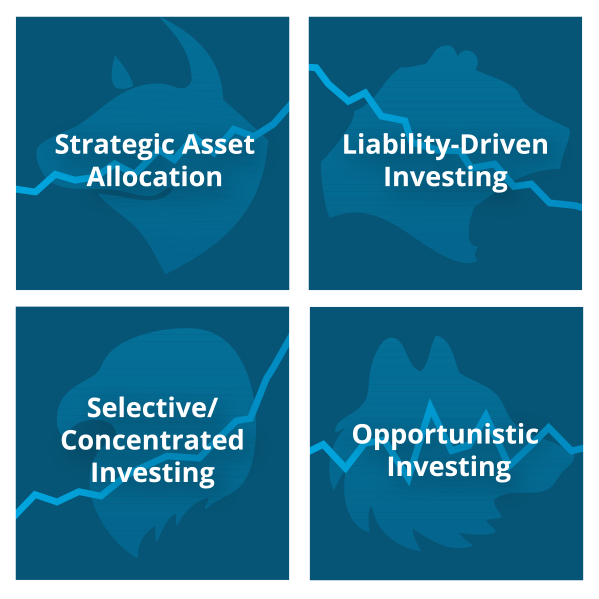
The Move Towards Absolute Return in Parts of the Institutional Investing World
During the period from 2007-2009 much greater attention has been paid to the use of hedge-fund-like “absolute return” strategies amongst institutional asset management portfolio managers. The phrase “absolute return” is used to differentiate the concept from the more traditional “relative return” mandates.
Relative return generally seeks performance relative to an appropriate benchmark in order to measure how well a portfolio has performed relative to the broader market over a certain time period. Relative return may gauge performance of a portfolio as “good” even if the performance was negative, assuming that the performance of the benchmark was more negative.
Absolute Return, on the other hand, seeks positive nominal returns in all market conditions (even in bear markets), even if those returns may lag the broader markets in bull market conditions. Hence, the benchmark used for most Absolute Return managers is often the 3-Month Treasury Bill because it is usually seen as the non-variable alternative “risk-free” asset. It is easy to see why such a concept would gain in popularity over the time period of the last two years. After all, who wants to pay a portfolio manager to generate negative returns?
In the past many institutional asset managers have shunned the use of absolute return methods largely because of the impracticality of applying them, the high costs often involved, the possibility of a high degree of human error, and the difficulty of predicting the future – which is essentially what many of these absolute return mandates (but not all) attempt to do. However, the last two years have provided proof for some that absolute return should hold a prominent place in an institutional portfolio because of its (at least theoretical) ability to manage risks to the downside, and its consequent ability to manage risks associated with the broader financial system in “irrational” or “inefficient” markets.
Some institutional portfolio managers have brought this absolute return approach to the “infinite time horizon” portion of their institutions’ investment portfolios, many of them with much success over the last two years. This success has come as a surprise to the more traditional “strategic asset allocation” portfolio managers, many of whom fared somewhat poorly during the recent downturns. The recently successful absolute return-focused managers have taken the approach of first applying the basic institutional method of creating an appropriate split between liability/fixed income needs and the variable (or infinite time horizon) portion of the portfolio. They then manage the variable portion of the portfolio as if it were a proprietary hedge fund according to an absolute return mandate. This differs from the traditional institutional style only in the management of the variable “infinite time horizon” portion, which traditionally has been successfully managed according to a more static “strategic asset allocation” approach.
A thorough explanation is required in order to fully understand the institutional asset management method in general, and also to understand the difference between the strategic allocation approach and the newly popular absolute return approach:
True Institutional-Style (INFINITE TIME HORIZON) Investing has 2 Primary Philosophical Components:
1. Liability Driven Investing - “Fixed-risk” component
· This is the portion of the portfolio (often the largest portion) that is meant to provide low risk reserves for known immediate or predicted future liabilities and risks. In the case of an insurance company or bank, this would be known as the “reserve.” This is the “fixed-risk” component.
· It typically includes Income Structuring using individual bond and other fixed income issues held to maturity
· This component may incorporate direct hedges using offsetting equity assets, derivatives, or insurances for hedging/insuring against specific risks and liabilities.
2. Infinite Time Horizon Investing – “Variable-risk” component
· The portion of the overall portfolio allocated to this component is often defined as the remainder of the assets not needed for immediate or known future liabilities/needs that can be invested over an infinite (or undefined) time horizon.
· This is the portion of the portfolio that is “at-risk”, and does not have a guaranteed, predetermined, or known future value, or the “variable-risk” component.
· In pure strategic asset allocation, this is the portion of the portfolio that would normally be occupied by various types of stocks and other variable assets such as commodities, real estate, or other hard assets. Each of the sub-components would have a specific predetermined percentage which would be systematically rebalanced towards over time. The focus here is on the correlation characteristics of the assets themselves, and not necessarily on methodology for actively manipulating those assets.
· In Absolute Return investing, this portion of the portfolio may be occupied by an unlimited breadth of security types (including additional fixed income/cash) actively managed according to a specific active methodology or series of methodologies. The focus here is on the methodology used to actively manipulate the composition of the portfolio, and Your In-advance view of New practical investment theory and research not necessarily on the basic historical asset characteristics, as in passive strategic asset allocation.
Redefining the Components of the "INFINITE TIME HORIZON" Portfolio
Infinite Time Horizon Investing using Traditional Strategic Asset Allocation:
In traditional institutional strategic asset allocation, a designated percentage of each the following commonly used traditional asset class and sub-class definitions is set for the “variable” component:
* US Large Cap Value, Blend, and Growth Stock
* US Mid Cap Value, Blend, and Growth Stock
* US Small Cap Value, Blend, and Growth Stock
* International Developed Markets Stock
* Emerging Markets Stock
* Real Estate Investment Trusts
* Commodities Exposure
The way that these traditional asset sub-class allocations have been filled in the past differs amongst portfolio managers, but one important thing to keep in mind is the philosophical difference between using “passive” and “active” managers. The use of passive management (index funds, or pure buy-and-hold methods) would indicate a belief of the portfolio manager that markets are largely “efficient” and that it is impossible or impractical to try to achieve above-market performance by using active/tactical methodologies. Contrarily, the use of active managers for each of the components of the strategically-allocated portfolio would indicate that the overlay portfolio manager believes that at least certain markets are “inefficient” enough that specialized actively managed components can reap above-index performance (i.e. A good specialized Small Cap Value Stock manager can consistently beat the index, and it is therefore worth paying for this active management through a higher expense ratio). This example implies a belief in at least some inefficiency within the small cap value section of the stock market.
Infinite Time Horizon Investing using Absolute Return:
When it comes to the ever-more-common absolute return style of institutional management, one or more of the following examples of absolute return management styles may be used for the “variable” portion of the portfolio:
* Constrained Tactical Core (Strategic/Tactical Hybrid)
* Unconstrained Tactical Asset Allocation (Historical Stat Market Timing)
* Unconstrained Tactical Asset Allocation (Opportunistic Market Timing)
* Unconstrained Tactical Income
* Global Macroeconomic
* Specialized or Broad Market Long/Short
* Distressed Securities
* Market Neutral/ Statistical Arbitrage
* Opportunistic Trading Strategies
* Technical/ Trend Following
* Special Situation/ Event-Driven/Merger
* Fund of funds
* And many others…
Strangely enough, the redefinition of the various potential portfolio components by the absolute return focused portfolio managers does not reflect a substantial difference in philosophy from the use of “active management” for each of the predetermined portfolio components under the more traditional “strategic asset allocation.” The real difference is in the degree to which the manager believes the market(s) are “inefficient” and in where inefficiencies lay. Generally an absolute return mandate would assume a higher degree of inefficiency. In addition, depending on the specific absolute return mandate, the managers of an active strategic and absolute return portfolios would likely disagree on where the inefficiencies in the market lay.
For example, whereas the active-strategic manager may believe that it is only possible for specific managers to capitalize on the market inefficiencies within their traditional area of specialization such as the small cap value market, the absolute return manager may believe that is possible to capitalize on large inefficiencies in pricing between the emerging economy bond markets and US Real Estate, as well as arbitrage opportunities between various other components of the world of investable assets. Essentially, the real difference between the two methods described is in the assessment of the degree and placement of risks/inefficiencies in the markets.
How can the Individual Investor Gain Access to an Absolute Return Style of Management?
To say that this style of management is truly available to the everyday investor means that it must be available to those with relatively low levels of investable assets. But in truth, the nominal level of investable assets is not particularly important for determining the appropriateness of this methodology for a client. What is far more important for determining suitability is that the investor’s current asset levels are sufficiently large relative to their immediate or predicted liabilities (meaning there are significantly more assets than are currently needed).
To apply this method properly for an individual investor will generally require a planner that is capable of manually structuring the Liability-Driven Investing component of the portfolio through various sources, probably largely through brokerage accounts or third party management programs, and overseeing a selected manager or series of managers for the absolute return investing component. The two philosophical components of the portfolio could be constructed using the following tools:
1. Liability Driven Investing Component
· Certificates of Deposit (CDs)
· Individual Bonds and Bond ladders*
· Inflation Protected Securities*
· Single Premium Immediate Annuities
· Variable Annuities with income guarantee riders
· Fixed Deferred Annuities
· Principal Protected Notes
· Equity-Linked CDs
· Options, Futures, Forwards, and other derivatives
*Alternatively, if not purchased individually, these could be acquired through traditional mutual funds or exchange traded funds (ETFs), but would no longer be truly “fixed”
2. Absolute Return Investing Component
* Individual Hedge Funds
* Funds of Hedge Funds
* Managed Mutual Fund/ETF Programs
* Unified Managed Accounts
* Separately Managed Accounts
* Individual Mutual Funds
A Practical Application of Absolute-Return-Focused Institutional Style Portfolio Management for the Individual Investor
An example of a client for whom this method may be appropriate is someone that is retiring at a relatively ripe age that has accumulated significant assets throughout their lifetime based on their habit of living well within their means. In such a scenario, the client may have significant assets above their structured income Liability-Driven portfolio needs to invest on an infinite time horizon (or very long time horizon) basis. Most people are not in such a scenario, but for those who are, the remaining “infinite horizon” assets could be invested in a hedge-fund-like manner, just as might be done by an institution. For our purposes, we will assume a $500,000 initial portfolio value, although we could conceivably find ways to apply the method for far lower investable asset levels (as low as $25,000-$50,000).
“FIXED-RISK” Liability-Driven Component
TIPS-Based Mutual Funds or ETFs- Liquid Inflation Protected Securities should be purchased in an amount equal to short term safety and liquidity needs (possibly 3-6 months living expenses), which will preserve inflation-adjusted principal and consumer purchasing power over time.
Individual Bond Ladders or bond ETFs in brokerage accounts/SMAs- Individual bonds of various types (government, corporate, municipal, etc.) should be purchased with laddered maturities and held to maturity, with bond coupons selected and timed to provide for all current and expected future income/ cash flow needs. For clients with sufficient assets, individual bonds selected either by the planner in a transactional brokerage account or by a bond portfolio manager in a fee-based separately managed account should be utilized. Clients with low levels of assets (ie $25,000-$100,000) may wish to consider using exchange traded funds to generate this income (for diversification purposes when diversification is not possible based on individual bond minimum purchase amounts).
Variable Annuities with Income Guarantee Riders and/or Single Premium Immediate Annuities- Variable annuities with guaranteed income riders or Single Premium Immediate Annuities should be purchased in amounts necessary to cover crucial fixed living expense needs that are expected to last throughout the client’s lifetime. SPIAs should be used for immediate high income needs (generally 5% of corpus or higher) that do not necessarily need inflation protection, while variable annuity riders should be used for slightly lower income needs (generally 5% of corpus or lower) either predicted in the future or that are current and require long term inflation protection.
“VARIABLE-RISK” Absolute Return Component
Depending upon the objectives of the client, the portfolio manager should select one or more absolute return mandates to complete the portion of the portfolio designated as “infinite time horizon” – the portion not needed for living expenses or other objectives. Alternatively, the portfolio manager may wish to diversify further by incorporating several sub-components in order to create a customized “fund of funds” for the client, which will (in theory) provide additional portfolio volatility reduction. In order to ensure that such a portfolio would be available at the lowest possible level of investable assets, one should assume the use of retail open end mutual funds or Separately Managed Accounts for these purposes rather than traditional limited partnership hedge funds. The number of such liquid hedge-fund-like instruments has been rapidly increasing over the last several months as a consequence of the newfound demand for these management mandates.
Information has been obtained from sources believed to be reliable and are subject to change without notification. The information presented is provided for informational purposes only and not to be construed as a recommendation or solicitation. Investors must make their own determination as to the appropriateness of an investment or strategy based on their specific investment objectives, financial status and risk tolerance. Past performance is not an indication of future results. Investments involve risk and the possible loss of principal.
Investors are asked to consider the investment objectives, risks, charges and expenses of the investment carefully before investing. Both the product and the underlying fund prospectuses contain this and other information about the product and underlying investment options. Please read the prospectuses carefully before investing. Guarantees apply to certain insurance and annuity products and are subject to product terms, exclusions, limitations and the insurer's claims paying ability and financial strength.







Leave a Comment